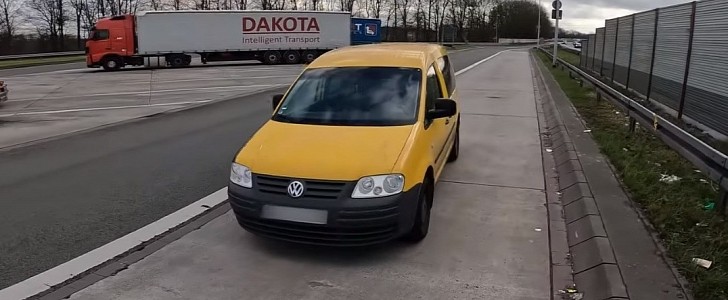Most, if not all, diesel engines found in modern vehicles are turbocharged, which allows them to offer a reasonable amount of power and torque for their displacement. Once upon a time, not that many diesel-engined vehicles had turbochargers, and their power was not exactly impressive.
While some of us have experienced the wonders of accelerating in a 3.0-liter naturally aspirated diesel engine in a passenger car, many have no idea that N/A diesel motors were inertia machines with a smaller rev band.
Thanks to a YouTube channel that focuses on this kind of content, we get to see what a 2004 Volkswagen Caddy 2.0 SDI is like to drive in 2022. The vehicle only had 69 metric horsepower (68 horsepower) to its name back when it was new, despite having a 2.0-liter displacement. Its torque output is just 140 Nm (102 lb.-ft.), which is not at all impressive for an engine of this size.
With not that much power to work with, nor with the torque that turbocharged diesel motors usually offer, all you had left to do was floor it and wait for the revs to build.
While that is perfectly fine as long as you do not jeopardize someone's safety when you merge on the highway, things get dicey as you drive on roads with one lane per way, where you have to pass slower cars as fast as possible. The same model can perform significantly better with a turbocharger, especially with a larger unit.
As you can observe, patience will help, and a reasonable driving speed on the highway is eventually achieved. Furthermore, with the right foot planted to the go-faster pedal, the Caddy SDI will manage to reach a speed that will lead to a ticket on speed-restricted sections of the highway.
In the case of the video below, the channel is focused on only using the unrestricted parts of the Autobahn, so everything you see is legal.
With that behind us, it is clear why naturally aspirated diesel engines were eliminated from the offers of many manufacturers. Not only were they the slowest, but drivers put themselves in danger when trying to pass other cars on national roads.
Thanks to a YouTube channel that focuses on this kind of content, we get to see what a 2004 Volkswagen Caddy 2.0 SDI is like to drive in 2022. The vehicle only had 69 metric horsepower (68 horsepower) to its name back when it was new, despite having a 2.0-liter displacement. Its torque output is just 140 Nm (102 lb.-ft.), which is not at all impressive for an engine of this size.
With not that much power to work with, nor with the torque that turbocharged diesel motors usually offer, all you had left to do was floor it and wait for the revs to build.
While that is perfectly fine as long as you do not jeopardize someone's safety when you merge on the highway, things get dicey as you drive on roads with one lane per way, where you have to pass slower cars as fast as possible. The same model can perform significantly better with a turbocharger, especially with a larger unit.
As you can observe, patience will help, and a reasonable driving speed on the highway is eventually achieved. Furthermore, with the right foot planted to the go-faster pedal, the Caddy SDI will manage to reach a speed that will lead to a ticket on speed-restricted sections of the highway.
In the case of the video below, the channel is focused on only using the unrestricted parts of the Autobahn, so everything you see is legal.
With that behind us, it is clear why naturally aspirated diesel engines were eliminated from the offers of many manufacturers. Not only were they the slowest, but drivers put themselves in danger when trying to pass other cars on national roads.







